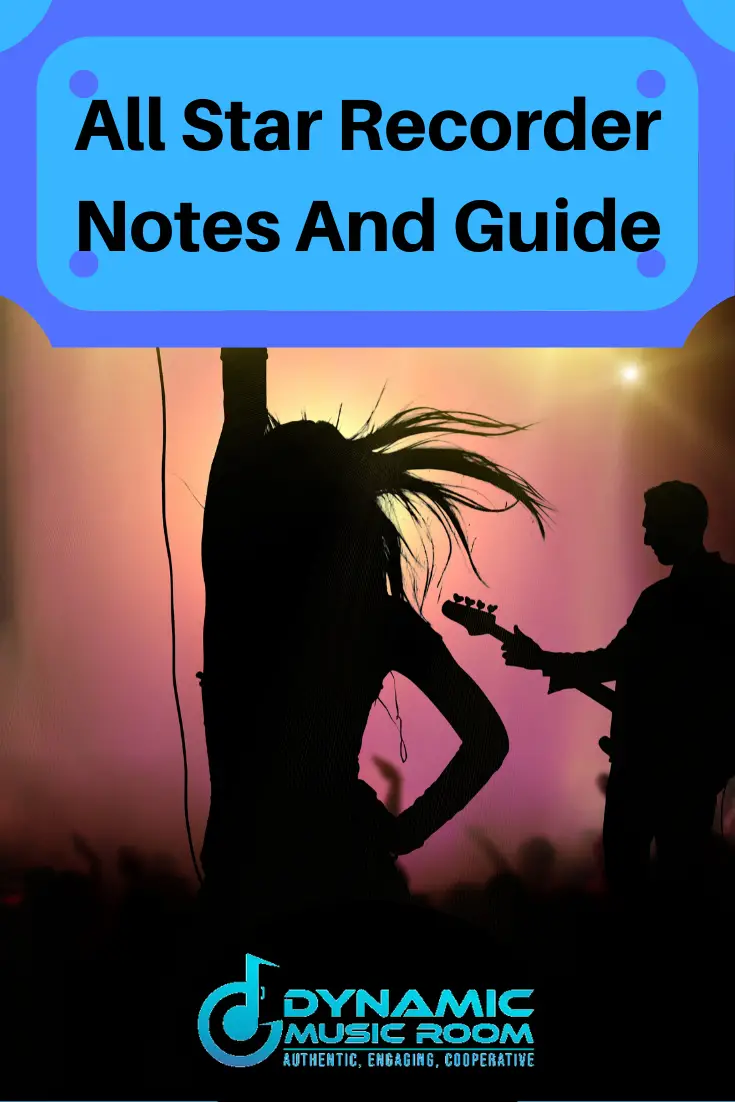Do you want to learn to play the iconic song from Shrek on recorder?
Are you looking for a fun and challenging song to give your 4th/5th grade recorder students?
I’m always looking for new ways to inspire my students to play, and part of this is by finding songs they’ll be excited to learn.
One of the most iconic popular songs is All Star by Smash Mouth. After my students showed interest in learning, I decided to figure it out and write down the All Star recorder notes for everyone to share.
The song, All Star, on recorder is medium-difficult song using the following notes:
- D
- C
- B
- A
- G
- E
- Low D (D,)
Look ahead for a breakdown of the notes used and how I teach the song to kids.
You may also enjoy learning about popular songs in solfege.
Table of Contents
Recorder Notes For All Star
The recorder notes needed for All Star are the trickiest part of the song. The rhythms may seem complicated, but because the melody is so well known, kids have very little trouble getting this nailed down.
Here are the notes with a verbal explanation of how to play them:
- D – middle finger on the second hole, no thumb
- C – thumb on the back, middle finger on the second hole
- B – thumb on the back, pointer finger on the first hole
- A – thumb on the back, 1st and 2nd fingers
- G – thumb on the back, 1st, 2nd, and 3rd fingers
- E – thumb on the back, 1st,2nd, 3rd finger on the right hand, Left-hand 4 and 5
- Low D (notated as “D,”) = thumb on the back, right hand 1, 2, 3, left-hand, 4, 5, 6
Note: The key is chosen to fit the recorder best, and some notes and rhythms are adapted to make it a little easier for the kids to play.
The verse and chorus are in the notation above.
How To Play All Star On Recorder
This section will break down how to learn or teach All Star on the recorder. Before attempting this song, students should be familiar with all the notes of the song.
This song serves the purpose of practicing the leaps between notes, not for teaching the notes the first time.
#1 Review Each Note
The first thing to do is review each note. Have students play each note several times in different rhythm patterns.
I recommend having them echo you as you play, so they better understand what good recorder tone sounds like.
After you play each note on its own, put the notes together in stepwise motion (except the minor leap for G to E). Do all the notes up and down the pentatonic scale.
#2 Isolate And Practice Leaps
Look at the notation as the teacher and isolate the leaps. Students and new players need to practice these outside of the context of the song to help with finger coordination.
Here are the leaps I recommend practicing:
- B → G → B
- G → E → G
- G → C → C
- G → high D → G
- High D → B → High D
- Low D → High D
- B → E
#3 Rhythm Say And Finger The A Section
Project or pass out the sheet music. Take a look at the A section of the music.
Tap your recorders or clap your hands while saying or counting the rhythm syllables. This may prove difficult for some, so you may just want to have the student echo you on a neutral syllable as well.
Now, hold the recorder and finger the notes slowly in rhythm while saying the letters. Do this 1-3 times to make it more comfortable.
#4 Play The A Section
Now, attempt to play the A section slowly. There will likely be mistakes.
Notice these mistakes and go back and practice only this part. After this part has improved, put it together with the rest of the A section.
For teaching a larger class, you may want the students to discuss the trouble spots or practice in small groups using fingers only.
Once it’s at 85% correct or higher, you may move on.
#5 Rhythm/Finger B Section
Do the same steps with the B section.
Always start with saying or tapping the rhythms. Then, put the fingerings and letter names to the rhythm.
It’s important to break them apart at first and then put the rhythms and note names together.
#6 Play B Section
As before, attempt to play the B section. We’re looking for 85% correct or higher to move on.
Always be ready to break it down into smaller pieces to fix and put it back together again.
#7 Put A And B Together
Now, it’s time to play the whole verse section by putting A and B together. Start slow and be forgiving as this is a hard song for many players.
If needed, go back to fingering A and B together to increase coordination. Point out and notice the leaps practiced at step #2.

#8 Repeat With C
Without saying the same thing over and over, you repeat step #3 and #4 with the C section. The rhythms here seem much trickier and faster, but if you imagine the melody, it falls into place.
#9 Repeat With D
Now do the same with the D section.
Despite the notes being stepwise (mostly) in this section, kids and adults always seem to have the trickiest time playing this section.
I’ve found it helpful to have the group sing the letters multiple times without fingering just to unify the feeling of the rhythm.
#10 Put Together C And D Sections
It’s time to put together the chorus. Break it down as needed and be patient. This song probably won’t be learned in a single class or practice session unless you’re much more advanced.
#11 Finger The Whole Song
It’s time to put together the whole song.
But this is so long compared to what the players have likely done, you need to review the fingerings for the whole song in a row.
I recommend doing this at least 3 times before attempting to play.
When people make mistakes while just fingering, it’s easier to recover and keep playing.
When the mistakes happen while actually playing, it seems like everyone freezes up for the rest of the song.
#12 Play The Whole Song
Now play the whole song! It will take practice to get it up to 85% or higher, but if you continue to isolate the parts giving trouble, it’s doable.
Believe me; I’ve seen it many times!
Final Thoughts
Now you know how to play All Star with recorder notes. As I said before, this is a great medium-difficulty song pushing students to improve their finger skills.
When in doubt, break it down by section and practice the specific notes giving you or the students trouble.
You may also enjoy these recorder resources:


